#fossil divider
Explore tagged Tumblr posts
Text

fossil theme (i just had to make a divider for artfight okay)
small version:

tiny version:

#artfight 2025#team fossil#sorry everyone just ignore this#dividers#fossil divider#artfight#these are free to use!!!!!
119 notes
·
View notes
Text




Fossil welcome for AF i made for myself but others can use - no need to credit
I have NO clue how to make the gif transparent and I'm tired of trying so i just colour picked the Art fight basic background colour so it shouldn't matter, if for any reason you want this with a different hex code bg let me know and I'll do it for you
Also different severities of flashy stars and one unmoving cause why not
#flashing gif#tw flashing#flash warning#flash#fossils#artfight decor#artfight#web stamps#web dividers#Welcome stamp#artfight fossils
21 notes
·
View notes
Text


Artfight headers/dividers
F2U and resize
16 notes
·
View notes
Text


Fossil divider! Can be used with credit
#might edit#artfight team fossils#team fossils#artists on tumblr#artfight#artfight2025#divider#fossils#my art
29 notes
·
View notes
Text
Boomers would hate this but playing video games has actually made me good at money management.
#unironically i treat my money the same way i do my animal crossing bells#what goes into savings stays in savings unless i am making a big payment#loans are paid off in 50k bell installments and i must have that equal that or more in savings#any money i earn from fish bugs fossils etc goes directly to savings with a set amount of 2000 bells left in my pocket#legitimately like i divide my paycheck every month between savings and checking#i only draw from savings if i overshot my spending that month and i must put it back the next month#my car payment is technically like 392 but i just do a straight 400#video games have legitimately made me good at managing my money#also having to save enough money for special items or weighing the costs of something against your game balance#has made me very good at online shopping of putting a bunch of shit in my cart and then methodically clearing it out over the next week
1 note
·
View note
Text
I was struck by how the entity’s growths formed in a spiral pattern, almost like a double helix you’d find in a strand of DNA. Oil is made from the fossilized remains of ancient plants and animals. It’s a sort of geological memory, just like how DNA is an evolutionary memory that allows the body to build and rebuild itself. And the primary thing that it affects when it touches people is their memories, whether random flashes of nostalgic images or deeply personally significant memories.
Going off of the DNA analogy…I don’t think the entity held any malice towards the crew. I don’t think it could hold malice to begin with, or goodwill, or any other more complex emotion. DNA is a chain of chemicals, and we have no conscious control over its transcription. The only thing it “wants,” as far as a chain of chemicals wants something, is to stay alive and to replicate itself. Its connection to oil also makes it feel like whatever dead, fossilized organic matter was trapped beneath the surface of the earth very mindlessly trying to return to life. The assimilated crewmates looked like cancerous lumps, growing out of control and endlessly dividing, not out of ill will, but because the cellular mechanism for growth had broken and was replicating out of control, only writ large, across the body of a whole person. The growths, like DNA writ large, a strand of chemicals trying to reassemble itself from whatever chemical matter from the rig and the crew it could use.
There’s a strange “humanity” to the entity, too, though in a very primal, instinctual sort of way. It wanted to be one with the rig and everyone on it, and it kept dredging up memories where Caz and the others felt especially close to their loved ones, even if they weren’t always happy ones. Caz, too, wanted to be one with his family again, but had that dream dashed by a selfish, individualist action. He wanted to keep his fellow crewmates together, and was increasingly devastated as assimilation or death cut them off from each other. The ending was beautiful, and felt like a barely comprehensible sort of kindness despite everything that had led up to it. For a moment, it felt like Caz reached an understanding with the force that had consumed him and that he in turn had destroyed, at least enough to forgive it and let go. In exchange, he got to relive the last time he and his wife were truly together, the morning he left for the rig. And then, over the empty ocean, we hear Suze’s tearful plea to Caz to come home, to reconnect with her, to be part of their family again. The letter felt like a summation of what Suze, Caz, and the entity itself wanted—to return home, to connect with others, to feel “whole” again.
976 notes
·
View notes
Text
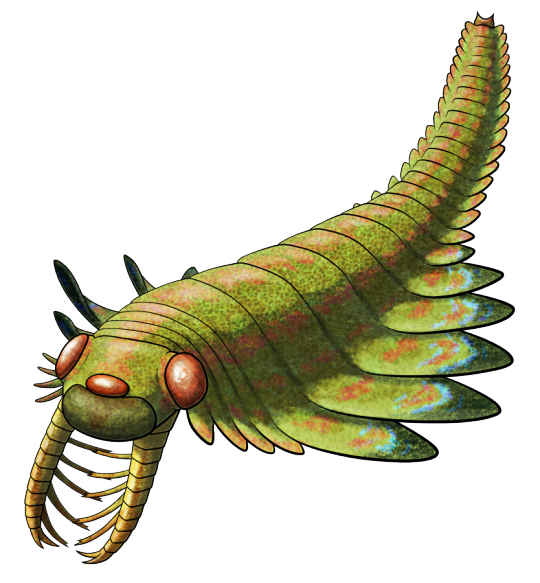
Mosura fentoni was a small radiodont living during the mid-Cambrian, about 508 million years ago, in near-equatorial shallow marine waters covering what is now western Canada.
Sixty specimens have been discovered in the Burgess Shale fossil deposits, ranging from 1.5cm long juveniles (~0.6") to 6cm long adults (~2.4"), giving us a detailed look at Mosura's anatomy and life history. It had three eyes – two on the sides of its head on short stalks and one in the middle of its face – and a pair of grasping frontal appendages each with six long sickle-shaped spines.
Unusually for a radiodont its body was divided into distinct regions: a four-segment neck, a six-segment mesotrunk with large swimming flaps, and an abdomen-like posterotrunk with up to at least sixteen segments (fewer in juveniles), all bearing gills along their undersides.
Its vaguely moth-like shape led to it being nicknamed "sea-moth" by field collectors, and inspired its genus name – "Mosura" is the Japanese name of the fictional giant kaiju moth-monster Mothra.
With a very high proportion of respiratory surface area for its size, Mosura was probably an active and agile fast-swimming predator, possibly living in low-oxygen waters around the outer continental shelf. Its wide oval central eye may have helped it stay orientated during rapid maneuvers, keeping track of the horizon line similar to the median eyes of modern dragonflies.
———
NixIllustration.com | Tumblr | Patreon
References:
Moysiuk, Joseph, and Jean-Bernard Caron. "Early evolvability in arthropod tagmosis exemplified by a new radiodont from the Burgess Shale." Royal Society Open Science 12.5 (2025): 242122. https://doi.org/10.1098/rsos.242122
"Plate Tectonics and the Cambrian World" Royal Ontario Museum, https://burgess-shale.rom.on.ca/science/the-burgess-shale/geological-background/plate-tectonics-and-the-cambrian-world/
Royal Ontario Museum. "Palaeontologists discover 506-million-year-old predator" ScienceDaily, 13 May 2025, https://www.sciencedaily.com/releases/2025/05/250513225800.htm
Stange, Gert, et al. "Anisotropic imaging in the dragonfly median ocellus: a matched filter for horizon detection." Journal of Comparative Physiology A 188 (2002): 455-467. https://doi.org/10.1007/s00359-002-0317-7
Wikipedia contributors. “Mosura fentoni” Wikipedia, 19 May 2025, https://en.wikipedia.org/wiki/Mosura_fentoni
#science illustration#paleontology#paleoart#palaeoblr#mosura#hurdiidae#radiodonta#dinocaridia#arthropod#stem-arthropod#panarthropoda#invertebrate#mothra
202 notes
·
View notes
Text
So I've thoroughly gone insane from the Predator: Killer of Killers trailer, and I will make you all part of my madness. I want to really look into the difference between our three new yautja. Each is in a different time period that the fandom has been BEGGING TO SEE. (granted, there are comics of the yautja coming to a head in the WW2 era but more depictions never hurt anyone)
I'm dividing up these three as Viking Yautja Samurai Yautja and Dogfight Yautja (Dogfight being the name for aerial close combat as seen in the trailer)
First, let's talk about Viking Predator, the one I consider to be the most prominent of the trio. I'll be using she/her to address her from here on out as it's my personal theory (and hope) that she could be our first on-screen female yautja, considering there's canon lore that makes women of the species bigger.
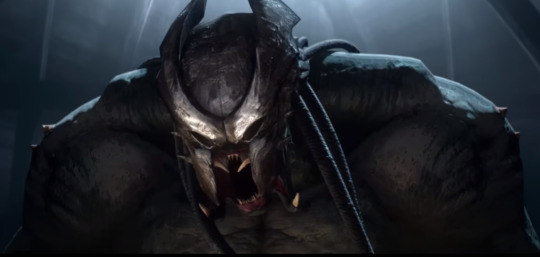
She's everything to me. SHE IS SO DAMN BIG AND I LOVE IT. JUST LOOK AT THOSE COLORS. She's ghastly, cold-toned, like a ghost. Her crest almost looks like pure fossil. Then there's tidbit from the trailer after she kills an approaching viking
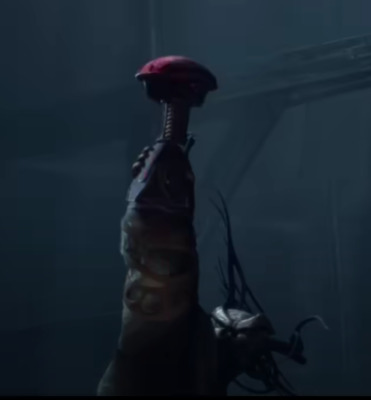
SHE HAS A GODDAMN HAMMER OF G O D FOR A HAND. Not only is this such a cool weapon, and some pretty neat depiction of a disabled yautja, but there's a story here, as seen in another moment of the trailer where she in fact has this hand still attached
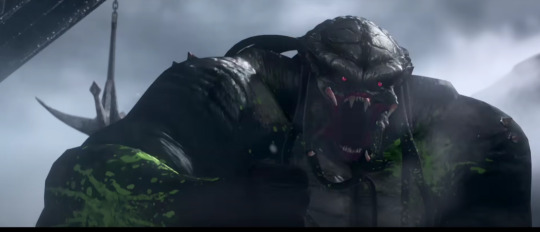
Is this a revenge story? Will we see her get her hand cut off AND the process of replacing it Ash Williams-style? Considering the series record of medical scenes, it only makes sense director Dan Trachtenberg would add that in.
Next, let's get onto Samurai Predator: He's sandy. Sandy as all hell.
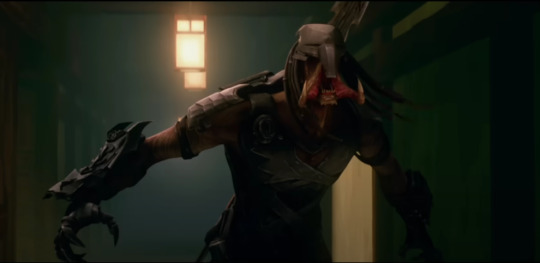
At first I wasn't so sure on the mask, makes him look so snoopy, but there's something very interesting about his face design. You can clearly see his bottom mandibles, but the top ones? Are they hiding?
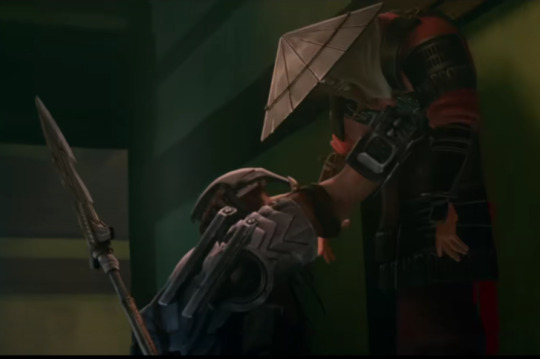
You can see his face underneath the mask just a bit, its pretty far off, so it creates a cover over him, but again WHHEEERREEE are those top mandibles?
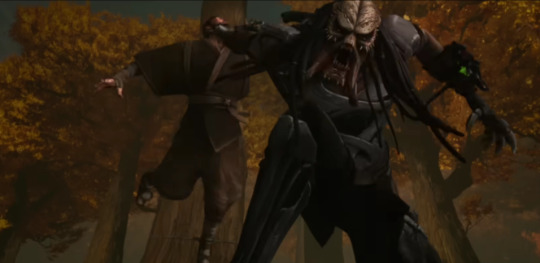
OH LORD I DONT THINK HE HAS ANY. Whether this is a case of his mandibles being ripped off, or simply born without them is a toss-up, but it's a cool bit of diversity if yautja can be born without top mandibles.
Fraid there's not much I can say about Samurai other than he's a more classic seeming character. Not imposing like Viking Yautja, but has a standard arsenal, taking on opponents in a closed space, very agile, and stealthy considering how much he uses cloak in his portions of the trailer. Finally. My husband.
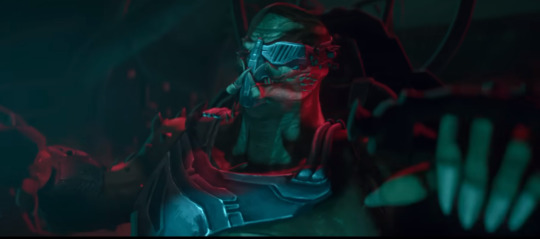
Dogfight is a SPECIAL case, because just look at him compared to the others. He is JAGGED. Missing eye, dreads SHEERED OFF to nothing, some kind of metal plating going down the center of his face. He has had a rough go at it, but he's also A FIGHTER PILOT. There's a look of sterness on him that is just almost chilling, he's calm, collected, and barely makes any noise compared to anyone else out of the trailer. He's the most "secured" of the group, but goddamn does he look like he takes the hunt seriously. Also this is WW2. I hope he kills nazis. That's all I can really say about these three, it is flat-out AMAZING we are getting so much distinction between their designs, their method of attack, and even shreds of personality here and there.
JUNE 6TH BABY JUNE 6TH
214 notes
·
View notes
Text
Round 3 - Reptilia - Charadriiformes




(Sources - 1, 2, 3, 4)
Our next order of birds are the diverse Charadriiformes, collectively called “shorebirds”. This large order contains the families Burhinidae (“stone-curlews” and “thick-knees”), Pluvianellidae (“Magellanic Plover”), Chionidae (“sheathbills”), Pluvianidae (“Egyptian Plover”), Charadriidae (“plovers”), Recurvirostridae (“stilts” and “avocets”), Ibidorhynchidae (“Ibisbill”), Haematopodidae (“oystercatchers”), Rostratulidae (“painted-snipes”), Jacanidae (“jacanas”), Pedionomidae (“Plains-wanderer”), Thinocoridae (“seedsnipes”), Scolopacidae (“sandpipers”, “snipes”, “curlew”, and kin), Turnicidae (“buttonquails”), Dromadidae (“Crab-plover”), Glareolidae (“coursers” and “pratincoles”), Laridae (“gulls”, “terns”, “skimmers”, and kin), Stercorariidae (“skuas”), and Alcidae (“auks”, “puffins”, “guillemots”, and kin).
Charadriiformes are small to medium-large birds that typically live near water, however, some live in the open sea, some live in dense forest, and some living in deserts. Most eat small animals ranging from invertebrates to fish to other birds. The order was formerly divided into three suborders based on behavior, the “waders”, the “gulls”, and the “auks”, but these three groups were paraphyletic. However, they represent a good summary of the main forms charadriiformes can take. The “waders” are generally long-legged, long-beaked birds which tend to feed by probing in the mud or picking items off the surface in both coastal and freshwater environments (however, terrestrial shorebirds like the Woodcock [Scolopax minor] and thick-knees [family Burhinidae] would also be considered “waders”). The “gulls” are generally larger species which catch fish from the sea, scavenge, or steal food from other animals. The “auks” are coastal species which nest on sea cliffs and dive underwater to catch fish, on flipper-like wings that can swim as well as fly. Now, it is generally understood that the auks are closer related to the gulls than any other family, and birds traditionally considered “waders” exist in all three suborders. Charadriiformes are one of the most, if not the most, widely dispersed bird orders, living on every continent and in almost every habitat.
Charadriiformes demonstrate a larger diversity of reproduction strategies than do most other bird orders (see propaganda below the cut for more). In most species, both parents take care of the young, but in some, the father is the main caretaker. Some breed and raise young in large colonies, while others nest alone.
Alongside the waterfowl, the Charadriiformes are the only other order of modern bird to have an established fossil record within the Late Cretaceous, living alongside the other dinosaurs. The modern groups of charadriiformes emerged around the Eocene-Oligocene boundary, roughly 35–30 million years ago.

Propaganda under the cut:
Many of the “stone-curlews” or “thick-knees” (family Burhinidae) are nocturnal, singing their eerie wailing songs at night. Suiting their nocturnal habits, they have very large, yellow eyes. They are effective hunters of insects, and some farmers will keep tamed thick-knees around their fields for pest control.
Like flamingos, the rare Magellanic Plover (Pluvianellus socialis) lives and breeds near saline lakes.
The unique Sheathbills (genus Chionis) are the only Antarctic birds without webbed feet.
Sheathbills and the Spur-winged Lapwing (Vanellus spinosus) have rudimentary spurs on their “wrists”, in place of wing claws, which they use for defense.
The “Trochilus” or “Trochilos”, sometimes called the “Crocodile Bird”, is a mythical bird first described by Herodotus (c. 440 BC), and later by Aristotle, Pliny, and Aelian, which was supposed to have been in a symbiotic relationship with the Nile Crocodile (Crocodylus niloticus), supposedly cleaning parasites and debris from the crocodile’s mouth and teeth. Various charadriiformes have been suggested as the inspiration for the Trochilus, including the Spur-winged Lapwing and Egyptian Plover (Pluvianus aegyptius). These birds are the most likely to feed around basking crocodiles, and tend to be tolerated by them, but this “tooth-cleaning” behavior has never been witnessed in the modern day. Nevertheless, the legend has become so prominent that these birds are sometimes still used as examples of symbiotic relationships!
The European Golden Plover (Pluvialis apricaria) spends its summers in Iceland, and in Icelandic folklore, the appearance of the first plover in the country means that spring has arrived. The Icelandic media always covers the first plover sighting.
The avocets (genus Recurvirostra) (image 2) are some of the only birds with upturned beaks. They use their strange beaks to feed on small invertebrates such as brine shrimp (genus Artemia) and brine fly (family Ephydridae) larvae.
The unique Ibisbill (Ibidorhyncha struthersii) has evolved a convergent appearance to the unrelated Ibises (subfamily Threskiornithinae), which are Pelecaniformes. Its long, downward-curved bill is used similarly to the ibises, as it probes under rocks or gravel for aquatic insect larvae.
Another charadriiform to convergently evolve with a pelecaniform is the Spoon-billed Sandpiper (Calidris pygmaea). While it is the size of a typical sandpiper, it has the spoon-shaped bill of a Spoonbill (genus Platalea). It has a similar feeding behavior to spoonbills, moving its bill side-to-side as it walks forward with its head down. However, this sandpiper typically feeds on tundra mosses, as well as small animals like mosquitoes, flies, beetles, and spiders, as well as brine shrimp occasionally. The Spoon-billed Sandpiper is critically endangered, and its population has been decreasing since the 1970s. It is estimated the species may become extinct in 10–20 years if its habitat is not protected. The Spoon-billed Sandpiper was the milestone 13,000th animal photographed for Joel Sartore’s The Photo Ark.
While oystercatchers (genus Haematopus) are monogamous and tend to return to the same nesting site every year, some have been observed “egg dumping”, laying their eggs in the nests of other birds such as gulls.
The Jacanas (family Jacanidae) (image 4) are sometimes referred to as “Jesus Birds” or “Lily Trotters” due to their highly elongated toes and toenails that allow them to spread out their weight while foraging on floating vegetation, giving them the appearance of walking on water. They are one of the rare groups of birds in which females are larger, and several species maintain harems of males in the breeding season with males solely responsible for incubating eggs and taking care of the chicks.
A “snipe hunt” is a type of practical joke or hazing, in existence in summer camps and scout groups in North America as early as the 1840s, in which an unsuspecting newcomer is duped into trying to catch an elusive animal called a snipe, a creature whose description varies. However, snipes (three separate genera in the family Scolopacidae) are actual birds, who search for invertebrates in marshland mud with their long, sensitive bills, and are highly alert. They would be hard to catch in a pillow case.
The Ruff (Calidris pugnax) is notable for having 4 separate sexes: 1 female and 3 types of male. The most common male, called the “territorial male” has a black or chestnut ruff, is much larger than the female, and stakes out a small mating territory in the lek. They perform elaborate displays that include wing fluttering, jumping, standing upright, crouching with their ruff erect, or lunging at rivals. The second type of male is the “satellite male”, which have white or mottled ruffs, are larger than females but smaller than territorial males, and do not occupy territories. Satellite males enter leks and attempt to mate with the females visiting the territories occupied by territorial males. Territorial males tolerate the satellite males because, although they are competitors for mating with the females, the presence of both types of male on a territory attracts additional females. The rarest type of male is the cryptic male, or "faeder", which permanently mimics the females in both size and plumage. Faeders migrate with the larger males and spend the winter with them, but use their appearance to “sneak” into leks and gain access to females. Females often seem to prefer mating with faeders to the more common males, and those males also copulate with faeders (and vice versa) relatively more often than with females. Homosexual copulations may attract females to the lek, like the presence of satellite males. Satellite males seem to be more attracted to faeders, and in homosexual encounters, the faeders are usually “on top”, suggesting that the satellite males know their true identity. The behaviour and appearance of each male Ruff remains constant through its adult life, and is determined by genetics.
The unique buttonquails (family Turnicidae) convergently evolved the small, round shape of the galliform quails. Unlike true quails, the female buttonquail is the more richly colored of the sexes. Both sexes cooperate in building a nest in the earth, but normally only the male incubates the eggs and tends the young, while the female may go on to mate with other males.
The stork-like Crab-plover (Dromas ardeola) is unique among waders for the shape of its bill, specialized for eating crabs, and for making use of ground warmth to aid the incubation of its eggs. The nest burrow temperature is optimal due to solar radiation and the parents are able to leave the nest unattended for as long as 58 hours, protected by large colonies of up to 1,500 pairs. The chicks are also unique for for being less precocial than other waders, and are unable to walk and remain in the nest for several days after hatching, having food brought to them. Even once they fledge they have a long period of parental care afterwards.
The skimmers (genus Rynchops) are the only birds which have a built-in underbite, where the lower mandible is longer than the upper. This adaptation allows them to fish in a unique way, flying low and fast over streams, letting their lower mandible skim over the water's surface, ready to snap shut the moment it touches a fish.
The Black Skimmer (Rynchops niger) is the only species of bird known to have slit-shaped pupils.
Gulls, Skimmers, and Noddies can see ultraviolet light.
The snow-white, pigeon-like Ivory Gull (Pagophila eburnea) breeds in the high Arctic and is an opportunistic scavenger. It has been known to follow Polar Bears (Ursus maritimus) and other predators to feed on the remains of their kills.
Some species of gull, such as the Laughing Gull (Leucophaeus atricilla) and Great Black-backed Gull (Larus marinus) have adapted to live alongside humans in places where humans have overtaken their habitat. These gulls have little fear of humans, and will pirate food from them just as they would any other animal.
Auks are superficially similar to penguins, having black-and-white colours, upright posture, and adaptations for swimming underwater. However, they are an example of convergent evolution, and are not closely related to penguins. Auks fill the niche of penguins around the arctic, while penguins fill the niche of auks around the antarctic.
In fact, the extinct, flightless Great Auk (Pinguinus impennis) was the original “penguin”. Penguin was the Spanish, Portuguese and French name for the species, derived from the Latin pinguis, meaning "plump". The penguins of the Southern Hemisphere were named after it because of their similar appearance and flightlessness. The last two confirmed Great Auks were killed on Eldey, off the coast of Iceland, on June 3, 1844.
194 notes
·
View notes
Text
Wet Beast Wednesday: bone-eating worm
Happy (almost) Halloween from us at Wet Beast Wednesday. What better to celebrate the spooky holiday than with a spooky animal? These critters are so spooky they even scare skeletons. Sometimes called zombie worms or bone worms, bone-eating worms are scavengers that play an important role in deep seas. Try not to get too scared.
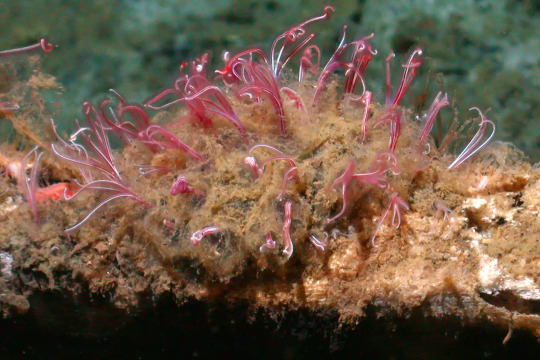
(Image: a cluster of bone-eating worms on a bone. Their plumes are visible, looking like red feathery structures emerging from a clump of brown sludge. End ID)
Bone-eating worms are members of the genus Osedax, with 26 species currently known. My favorite is Osedax mucofloris, which means "bone-eating snot flower". They are small tube worms, reaching between 2.5 and 7 cm (1 to 2.7 in) in length. The body is divided into three segments, the trunk, ovisac, and root. The trunk makes up the majority of the body and it topped by red plumes that act as gills. At the base of the trunk is the ovisac, where eggs are produced. Below that are the roots that bore through the bones the worms live on. This is done by secreting carbonic acid that is produced through anaerobic respiration. The roots also produce a mucus sheath whose purpose is not fully known. It may protect the body from the acid or may prevent the acid from dissolving the hole the worm lives in. As with other tubeworms, the worm generated a protective sheathe to live in. Normally, the plumes extend out of the sheathe to respirate, but when threatened, they will withdraw into the tube.
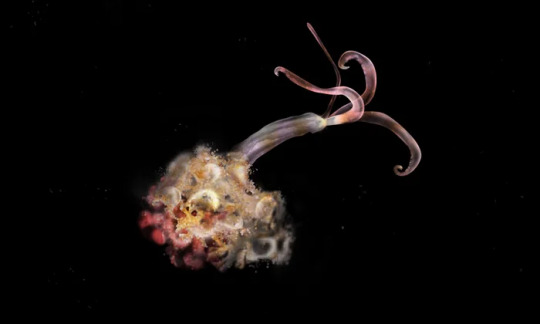
(Image: a bone worm removed from the bone. It is a long, translucent tube with reddish plumes on one and a lump of wavy roots on the other. End ID)
Bone-eating worms lack a mouth, anus, and digestive system. To obtain nutrients, they exist in a symbiotic relationship with bacteria. As the worms break down the bone, they release lipids and proteins that the bacteria consume to produce energy in the form of glycogen, which is transferred to the worm. The worm then uses the glycogen to power itself and feeds it to the bacteria to keep them alive. The worms also use collagen, which is the primary component of bone. Many of the symbiotic bacteria species need the collagen, which the worm provides by breaking down the bone. Curiously, many of the symbionts produce toxins that disrupt the membranes at the roots, leading to infection. The bacteria are also found surviving outside of symbiosis with the worms Because of this, it is debatable whether the relationship between the worm and its bacteria is mutualistic (both parties benefit) or commensal (one party benefits, the other neither benefits nor suffers).
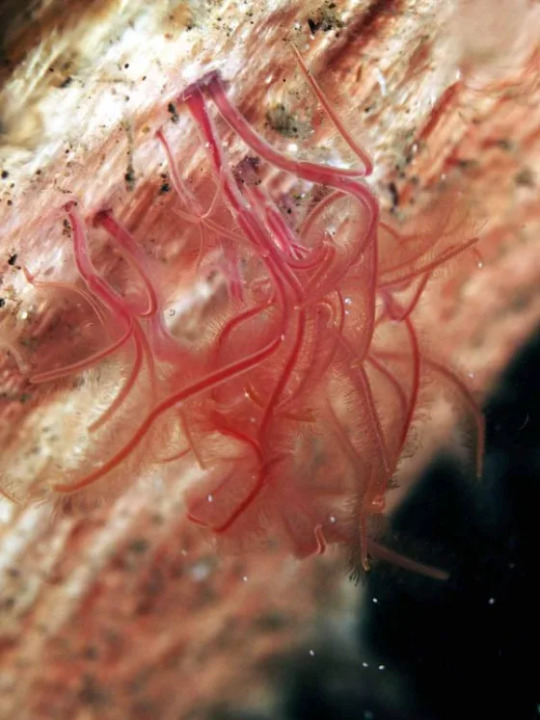
(Image: a cleared view of bone worm plumes emerging from a bone. End ID)
Bone-eating worms are found worldwide in oceanic depths ranging from 10 to 4,200 meters (30 to 14,000 ft). They are most commonly found on the skeletons of whales, but will also colonize fish bones and even, in one experiment, cow bones. Whale bones seem to be preferred both because of their large size and the large quantity of lipids found within. Whale skeletons can often be seen covered with bone worms, giving them the appearance of red shag carpeting. As the worms break down bones, other animals can take better advantage of the nutrients within. The presence of bone worms at a whale fall has been shown to increase the biodiversity of the site. Bone-eating worms are ecosystem engineers, organisms that significantly alter their habitat. They have been doing this since before whales existed. Fossil sea turtle and plesiosaur bones have been found with signs of bone worm colonization.

(Image: a lone bone worm with its tube visible. Its plumes are whitish. End ID)
The bone-eating worms have one of the most dramatic cases of sexual dimorphism in the animal kingdom. All the worms you see when you look at a whale skeleton are females. The males are 20,000 times smaller and fully microscopic. They still resemble larvae, making them a case of neoteny, an adaptation where juvenile characteristics are retained into adulthood. Harems of males live inside the females' tubes and feed on the nutrients released by the bacteria. As the female generates eggs, the males fertilize them. The eggs hatch inside the female's tube and stay for a while to mature before being released into the water. The fact that the worms are so widely distributed indicated that the larvae can travel vast distances to find a new set of bones, but the means they use to do so is unclear. The extreme sexual dimorphism reduces competition between males and females and ensures the males will always have an available mate to pass on their genes. The species Osedax pirapus do not follow this form of dimorphism. Males are still smaller than females, but they actually look like worms and share the same lifestyle. This increases competition between males and females, but ensures that males can make far more sperm due to their greater size.
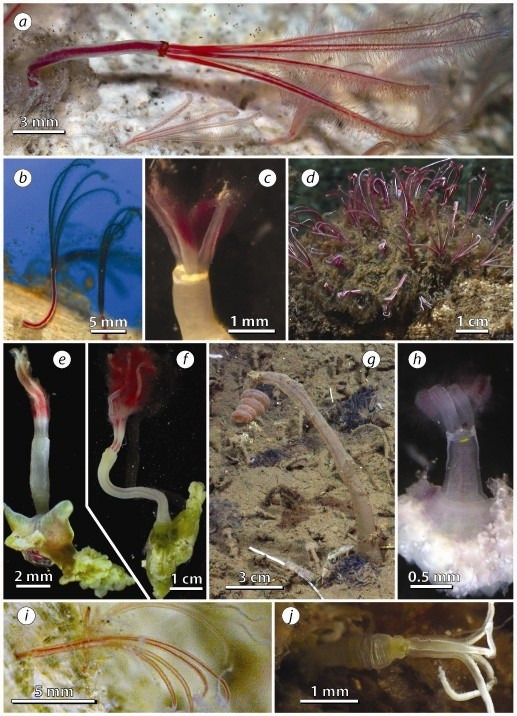
(Image: a collection of images of multiple species of bone-eating worms. Source. End ID)
#BONES FOR THE BONE WORM#wet beast wednesday#bone eating worm#bone worm#zombie worm#osedax#worm#tube worm#polychaete#wormblr#halloween#whale fall#invertebrates#invertiblr#marine biology#marine life#biology#ecology#zoology#animal facts#informative#educational#image described
233 notes
·
View notes
Text
Make You Wish Chapter Four -- Vox
Pairing: Alastor x Reader
Warnings: I don't think there are any for this chapter? Correct me if I am wrong.
Word Count: 1,225
Previous Part: Chapter Three -- A Reunion
Master Lists
Hazbin Hotel Master List
Make You Wish Master List
A/N I wasn't planning on posting this until tomorrow, but it seems to have some rather excited fans so here is chapter four (and the fourth thing I'm publishing today. We're very done for the day. I am tried and have actual work to do.) Also guys, I'm screaming. I accidentally deleted the whole things right before I was gonna post it. Thankfully I had a draft from when it was almost done save but like, god that sucked.
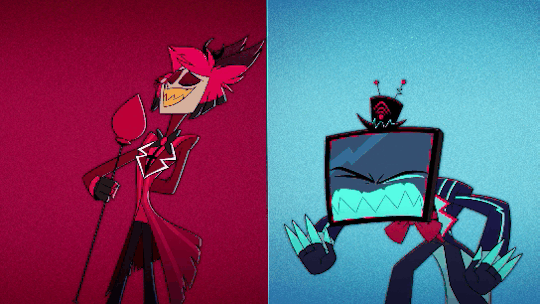
On the screen was Vox, seated behind a desk.
"Top of the hour and we're discussing a certain has-been how has been spotted cavorting around town after a seven year absence." Vox was saying, a poorly drawn image of Alastor displayed on the screen to his left.
Y/n saw Alastor's ear twitch with irritation.
"Yeah." she sighed, folding her arms across her chest, "Vox has gone kinda crazy since you left. I told you, things got tough."
"Did anybody miss him? Did anybody notice? More on tonight's program." Vox said through the TV, shuffling a stack of papers.
Alastor changed the channel with another flick of his finger.
"Hun, don't worry yourself with it." Y/n advised, "He's still gonna be there tomorrow."
The new channel showed a talk-show set up, Vox-2-Nite, where Vox was both host and guest.
"So, the old Radio Demon is back in town." host Vox was saying to himself as guest.
"Why is he hanging around?" guest Vox asked, taking a sip from a mug that had 'fuck Alastor' written on the side.
"Al." Y/n warned, sensing her friends irritation growing.
"What does that mean for your family?" Host Vox asked before Alastor changed the channel again.
Vox was on the screen again, before a bright red curtain.
"Well, handily, I've got good news." he was saying theatrically, "He's a loser, a fossil, and I don't mean to sound hostel-"
Alastor changed the channel again. This time to one of Vox's mega church broadcasts. Vox stood in the center of the screen wearing a pope's hat with an inverted cross on it.
"But the demon is a coward!" he announced, his words matching the previous channels sentiments perfectly.
"Jesus, V." Y/n asked, eyes wide, "How many channels are you running this on?"
"You can take that as gospel. Pulling my viewers? Impossible. I'm visual, he's barely audible."
"Y/n." Alastor hummed, his eyes still fixed on the screen.
"Yeah?"
"You wont mind if I handle this quickly. We can have our little chat after, I promise. It wont take more than a moment."
"I don't know, Al..." Y/n sighed, crossing her arms and tapping her foot slightly, "This isn't good for you, letting him get under your skin like this."
Alastor changed the channel again. A cooking show appeared and Vox was standing before the oven, singing along to the music playing in the background.
"But he should've stayed away! While he hid in radio, we pivoted to video!"
Vox on screen turned to the oven as he sang, opening it and pulling out a deer's head on a plate. Y/n bristled at the site, her horns growing just the tiniest bit longer, her teeth just the smallest bit sharper.
"And now his medium is getting bloody rare!"
"Al?" Y/n asked sharply.
"Yes, darling?"
"I lied." Y/n turned to face him, "He took this shit musical. Rip him a new one."
"Oh!" Millie exclaimed, excitedly grabbing onto Moxxie's arm, "We're gonna get a show!"
Alastor's grin widened at Y/n's words, if that was even possible. He stuck his hand out to the side, his microphone materializing in his grasp.
"Lucky for me, I've got the best voice this side of the divide on my side." he noted, shooting Y/n a look.
Her eyes flashed red.
"You flatter me."
Alastor brought his microphone to his mouth, suddenly exceedingly calm. The imps present in the room watched in shock as his ears flattened along his head.
"Salutations, good to be back on the air!" he announced into the device, "Yes I know it's been a while since someone with style treated hell to a broadcast. Sinners rejoice!"
Vox's brow furrowed on the TV screen as he inched up close to the camera.
"What a dated voice." Vox shot back, clearly listening to Alastor's broadcast on the set of his cooking show.
"Instead of a clout chasing, mediocre, video podcast." Alastor continued, not showing any sign he had noticed the TV demon's insult, "Is Vox insecure, pursuing allure? Flitting between this fad and that, is nothing working?"
"Ignore his chirping!" Vox commanded from the TV.
Y/n laughed and, turning to face Alastor, realized the man held a hand out to her. With a smile, she took it and he spun her into his arms as he spoke. The music echoed through the office as Alastor raised the volume on the TV once again.
"Every day he's got a new format."
Alastor spun Y/n back out again as the pair began dancing.
"You're looking at the future!" Vox yelled back, "He's the shit that comes before that!"
As Alastor spun Y/n back into his arms, she laid one of her hands on top of his holding the microphone and pulled it closer to her face.
"Is Vox as strong as he purports, or is it based on his support?" she sang in a clear voice, Blitzo, Millie, and Moxxie's eyes widening with recognition at the sound, "He'd be powerless without the other Vees."
"That's true!" Alastor noted, pulling the microphone back to himself as Y/n let go of his hand and he spun her back out again.
"It can't be..." Moxxie muttered under his breath.
"Holy shit!" Millie cut him off, excitement creeping into her voice, "There's no way, Y/n is the guest star?"
"The fuck are you two talking about?" Blitzo asked, turning to Millie and Moxxie as they watched the couple continue to dance.
"Well, Sir," Moxxie began, fiddling with the cuffs of his jacket, "back before the Radio Demon went missing, he used to bring guests onto the show on occasion. There was one guest he never named during his broadcasts however. She mostly just sang songs and chatted with him but, she sounded an awful lot like Y/n did just now."
"You don't say." Blitzo hummed, his arms crossed as he turned back to Y/n and Alastor, "So much for little miss 'oh, my life has been so boring. You'd probably just fall asleep if I started talking about it!' She is so gonna get it later."
Alastor let go of Y/n's hand and leaned into the microphone, beginning to sing as well, using the music emanating from the TV as a base.
"And here's the sugar on the cream: he asked me to join his team!"
"Hold on!" Vox yelled.
"I said no and now he's pissy, that's the tea!" Alastor finished, ignoring the demon once again.
"You old timey prick!" Vox exclaimed, his face glitching slightly as Y/n wandered back over to Alastor.
She leaned an elbow on his shoulder, tilting her head to the side in amusement as they watched Vox struggle.
"I'll show you suffering!"
"Aww, the TV is buffering." Y/n said, leaning into the microphone, her voice dripping with sickly sweet pity.
"I'll destroy yoo-o-u-u" Vox exclaimed as his technical difficulties seemed to grow worse.
Alastor and Y/n exchanged a wicked pair of smiles as the TV flickered out. Shadows crept from the edges of the room, encircling their feet. Alastor held an arm out to Y/n once again which she took with a smile. In a flash of darkness, they were gone.
"What the fuck was that?" Loona asked, stalking into the room.
----
Next Part -> Chapter Five -- The Conversation
#x reader#fic writer#x reader fics#x reader writer#alastor#alastor the radio demon#alastor x reader#fanfic#fanfic writer#hazbin alastor#alastor hazbin hotel#hazbin hotel alastor#alastor fanfiction#the radio demon#radio demon#hazbin hotel x reader#hazbin#hazbin hotel#make you wish#helluva boss x reader#helluva boss x y/n#helluva boss x you#alastor hazbin hotel x reader#hazbin hotel fanfiction#hazbin hotel x you#hazbin hotel x y/n#alastor x you#x reader fanfiction#x you#x reader fanfic
606 notes
·
View notes
Text
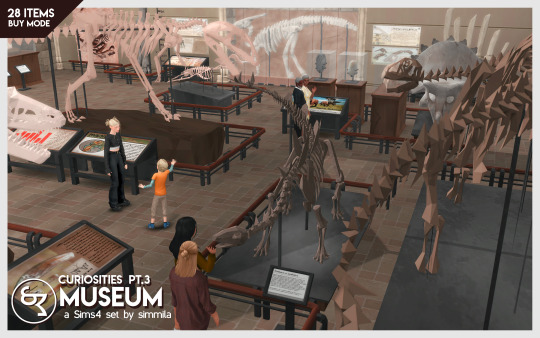
Curiosities pt.3: Museum - Now Free!.
Hello hi! I'm so excited to finally share the third part of the Curiosities set with you! This set is something that i feel like i just want to keep working on and on, mostly because i love the theme and working on the meshes has been so fun! But i will take a small break from this set so i can find fresher ideas for the next and final part of it, and i will start working on the manga set! (The poll ended on a tie, but decided to start with the manga set since its the one that received more comments and suggestions! (: looking foward to start working on it!)
---
I want to share credits to the sources i used to create this pack:
*Most of my dinosaur exhibits were inspired by real life reconstructions displayed on museums, including the Royal Tyrrell Museum in Canada (x), the Natural History Museum in London (x), the Field Museum of Natural History in Chicago (x) and Helsinki's Natural History Museum in Finland (x).
*I used Scott Hartman's work (x) in order to see the reconstructions in 2D, sadly since i needed to lower the polygons on my meshes i couldn't preserve as much detail on the dinosaurs, but if you are interested to learn more i highly encourage you to visit his page.
*If you are interested in learning more about the loss of Stromer's Spinosaurus during WWII here is a link that shares its story (x).
*For some swatches on the info panels i used my own edited screenshots from Prehistoric Kingdom's Game, you can find it on Steam! (Currently in early access).
---
---! This pack is was on Early Access, but went public on July 28th. !---
By becoming a 🍰 or 🎂 member you can unlock all my Early Access Content.
---
THIS PACK INCLUDES A TOTAL OF 28 OBJECTS:
(all new meshes and original textures unless stated otherwise)
-* 4 Variants of Displays -- (7 swatches)
-* Height Wall Decal -- (8 Swatches)
-* Wall Info Panel -- (13 Swatches)
-* Gorgosaurus Wall Fossil -- (4 Swatches)
-* Fence (front, inner and outer corner) -- (7 Swatches)
-* Glass Divider (3 wall heights) -- (5 Swatches)
-* 2 Versions of Individual Fossilized Eggs -- (8 swatches)
-* 2 Versions of Fossilized Nests (Theropod and Hadrosaur) -- (5 Swatches)
-* Sauropod Leg Fossil -- (4 Swatches)
-* Tapejara Fossil (1 Floor and med/tall ceiling versions) -- (5 Swatches)
-* Parasaurolophus Fossil -- (4 Swatches Each)
-* Stegosaurus Fossil -- (5 Swatches)
-* Tyrannosaurus "Sue" Fossil -- (5 Swatches)
-* Camarasaurus Fossil -- (5 Swatches)
-* Giganotosaurus Fossil -- (5 Swatches)
-* Adult Triceratops Skull -- (4 Swatches)
-* Young Triceratops Skull -- (5 Swatches)
-* Stromer's Spinosaurus Spine Replica -- (5 Swatches)
-* Small Info Plaque -- (8 Swatches)
-* Info Display -- (23 Swatches)
-* Backdrop Landscape (Build Mode: Wallpaper) -- (6 Swatches / Edited Screenshots from Oasis Springs, Chesnut Ridge and Tomarang)
---
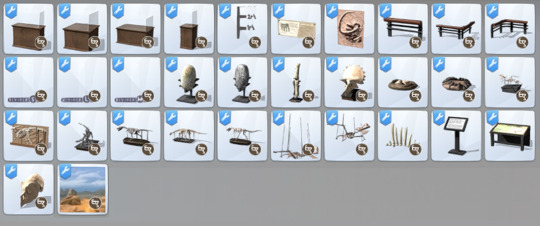
---
You can find this Pack by typing "Simmila", "Curiosities" or "Museum" on the search bar.
I *highly* recommend having bb.moveobjects on, since most of these objects have huge footprints!
--- Patreon (x)
With love,
Simmila
#the sims 4#ts4#sims 4 maxis match#the sims community#simblr#ts4 simblr#sims 4#sims 4 cc#sims 4 build cc#sims 4 buy cc#sims 4 custom content#sims 4 creator#Sims 4 new cc#simmila cc#ts4cc#sims4cc#sims4 custom content#the sims cc#the sims 4 custom content#dinosaur cc#build cc#wall cc#bb cc
359 notes
·
View notes
Text

Oroperipatus tiputini: A new species of Velvet Worm from the Ecuadorian Amazon.
Velvet Worms, Onychophora, are a unique group of elongate, soft bodied, many legged Animals, given phylum status and considered to be among the closest living relatives to the Arthropods. They are currently the only known phylum of Animals known entirely from terrestrial species, both living and fossil, although they may be related to the Lobopodans, an entirely marine group known only from Early Palaeozoic fossils. The 230 living Velvet Worm species are divided into two groups, the Peripatidae, found in the tropics of Central and South America, the Antilles Islands, Gabon, India, and Southeast Asia, and the Peripatopsidae, found in Chile, South Africa, Papua New Guinea, Australia, and New Zealand. All South American members of the Peripatidae are placed within a single clade, the Neopatida, which is further divided into two lineages, the 'Andean' genus Oroperipatus, and the 'Caribbean' lineage, comprising all other genera. Read the paper: (https://zse.pensoft.net/article/117952/) The new species is described from five male, three female, and three juvenile specimens collected in the vacinity of the Tiputini Biodiversity Station of the Universidad San Francisco de Quito in Orellana Province, Ecuador, between 2001 and 2023, as well as one youngling, which one of the female specimens gave birth to in captivity. The new species is named Oroperipatus tiputini, in reference to the location where it was discovered. Adult female specimens of Oroperipatus tiputini very between 46 and 65.3 mm in length, while the adult males are smaller at 22.7 to 39.8 mm. Females have between 37 and 40 pairs of legs, while the males have between 34 and 37, although one male specimen had a different number of legs on each side, with 35 legs on the right and 36 legs on the left. The species shows considable colour variation, with one adult male being a light brown colour with a faint rhomboid pattern, two adult males and one adult female being brown with orange diamonds, and another female (the one which produced a youngling) being a plain dark orange colour. The youngling itself was yellowish with a diamond pattern. All specimens were darked on their heads and antenae, had orange or brown legs, and a distinctive white band on the head. Most specimens of Oroperipatus tiputini were found on small herbaceous Plants within old growth, closed canopy upland forests around the Tiputini Biodiversity Station. Other specimens were found in leaf litter, or on the butress roots of trees to a height of about 70 cm above the ground. One specimen was found in a Bromiliad. The Worms were more active at night.
IMAGE: Colour variation in the life of Oroperipatus tiputini. (A) Adult male paratype, ZSFQ-i8270; (B) adult male paratype, ZSFQ-i5151; (C) adult female holotype, ZSFQ-i8248, and youngling paratype, ZSFQ-17794, a few days after being born. All photographs were taken at the Tiputini Biodiversity Station. Photographs by Pedro Peñaherrera (A), (C) and Diego Cisneros-Heredia (B).
307 notes
·
View notes
Text
“Sometimes it gets so hot, I can’t think straight,” said Chunara, sporting a black smartwatch that contrasts sharply with her colourful bangles and sari.
Chunara is one of 204 residents of Vanzara Vas given the smartwatches for a year-long study to find out how heat affects vulnerable communities around the world. The watches measure heart rate and pulse and track sleep, and participants get weekly blood pressure checks.
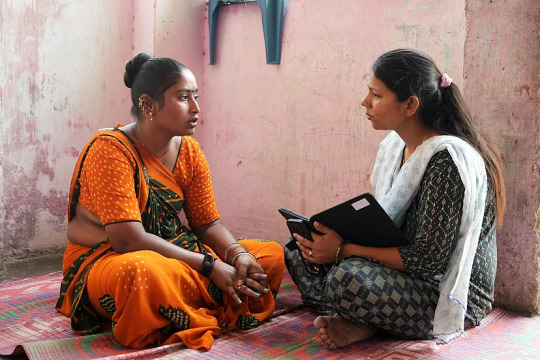
Data collector Komal Parmar, right, talks with Sapnaben Chunara to get heat related information in Ahmedabad, India.AP Photo/Ajit Solanki
Researchers also painted some roofs with reflective paint to reduce indoor heat and will compare them to homes without so-called cool roofs using indoor heat sensors. Along with the smartwatches, this will help them understand how much cool roofs can help poor households deal with India’s scorching summers.

A man applies reflective paint on the roof of a house to reduce indoor heat in Ahmedabad, India.AP Photo/Ajit Solanki
Chunara, whose home didn't get a cool roof, said she's happy to participate by wearing the watch, confident the results will help her family, too.
"They might paint my roof as well, and they might be able to do something that helps all of us in this area cope with the heat better,” Chunara said.
An increasingly hot planet, due largely to burning fossil fuels such as coal and gas that release carbon dioxide and other greenhouse gases, means already hot regions are getting even worse.
A 2023 study estimated that if the global mean temperature continues to rise to just under 2 degrees Celsius, there would be a 370 per cent rise in heat-related deaths around the world, and most would happen in South and Southeast Asia and Africa.
“This is a big concern, and it also shows the heat divide” between the poor and wealthy, said Abhiyant Tiwari, a climate expert with the Natural Resources Defence Council and part of the group conducting the research in Ahmedabad.
In the summer of 2010, the city witnessed nearly 1,300 excess deaths — how many more people died than would be expected — which experts found were most likely due to high temperatures.
Following the 2010 tragedy, city officials, with help from public health and heat experts, devised an action plan to warn citizens when the heat is at dangerous levels and prepare city hospitals to respond rapidly to heat-related illness. The plan has been replicated across India and other parts of South Asia.
I studied design in Ahmedabad's National Institute of Design. Reading this helps explain the design of our campus, architecture that emphasized air circulation and natural cooling. Mind you, I was there umpteen million years ago in 1989-1990.
#solarpunk#solar punk#community#jua kali solarpunk#solarpunk granny#informal economy#heat#poverty#climate change#ahmedabad#action plans#research
88 notes
·
View notes
Text
Reading Shadow Of Perseus So You Don't Have To

Okay, before starting to actually dissect this book I cannot help but notice that the author inserted these fragments in her novel:

"Oh, look at me! I just copy n' pasted some random ancient texts in my shitty retelling to prove that I did my own search and I know what I'm supposed to write about. I'm so smart y'all! 🤓"
Anyway, this book is written from the POVs of different women from the life of Perseus. First we have Danaë's POV, then Medusa’s, then Andromeda's and then Danaë’s again. *sighs*
Chapter One
Danaë has a handmaid named Korinna. Which yes, I know that it's actually a greek name and that it comes from kore, but it's kinda funny to me since here Corina is that one middle-aged woman who sits on the balcony while gossiping the entire town and spitting seeds in your head.
Danaë is currently in Larissa, giving offerings at the temple of... Apollo and Artemis?! I'm sorry, but the author does know that these two generally had separate temples, right? Right?!


Are you gonna tell me that Danaë's mother is dead or something?! Or that Acrisius wants to remarry a girl who's probably younger than his own daughter instead of expecting a grandchild from her instead?! Bitch, that man was probably so old he needed two packages of Viagra™ and a hot chick to put a finger in his ass in order to get a boner if the best he was able to do in his prime was one or two daughters.
Side Note: We're still at the second page of this retelling, by the way...
Okay, we're told that Danaë never left Argos before but would want to travel around the world because... her cool uncle told her many stories throughout time. Are you gonna tell me that you're going to turn even Proteus into a nice guy just so that your Perseus would look like the ultimate Genghis Khan with a personality disorder?! Really?! I mean, SERIOUSLY?!
After leaving the temple the two women make their way to the city. But Danae knew they had no reason to fear. No one in Argos would dare harm the daughter of Akrisios, nor one of his slaves. Alright, quick question: How do people, who lived in an era where stuff such as television, photography, posters etc. didn't exist, knew how does the princess of Argos looks like unless she traveled so oftenly that citizens got used of her face? Especially considering the fact that back then women usually had a more secluded life.
"Argos had no shortage of men hoping to marry Akrisios’s only daughter. But as each one presented himself, her father found a reason to reject them. They were too fat, too thin, too poor, too wealthy, too foolish, too clever."
Sooo... basically any average balkan father? I'm confused, is this supposed to depict him in a worse light? Anyway, Danaë is now musing about how many men her father rejected even when she found them handsome and wanted to marry them for the rest of this chapter or so.
Chapter Two
Danaë turns back to the "Golden House" (which honestly sounds like some sort of a hotel which makes this retelling even more absurd) where she finds her father and uncle complaining again.

Not gonna lie, this is the most accurate fragment from this book so far.
Danaë then joins her cousins at the table, which by the way have the exact same personality (none, that is), divided into three.
"Like his twin brother, Danae’s uncle had begotten no sons, and yet he did not seem to resent the fact. He doted on his three daughters as if they were the greatest gifts the gods could have bestowed."
youtube
First of all, Megapenthes is right here! Second of all, the greatest irony out there is that Acrisius DID love and care for his daughter before finding out about the prophecy, which makes her imprisonment even more tragic. Sanitizing the exact same depraved fossil who assaulted Danaë and even his own daughter in one obscure source in a so-called "Feminist" retelling should perhaps make you consider to abandon writing this book. Unfortunately we're only at chapter 2 and there are 44 more chapters that will follow. *sighs*
"Her grandmother used to say that they had quarreled even when they were in the womb, and although Danae knew she was joking it didn’t seem improbable."
Oh trust me, she was NOT joking! By the way, did you know that Danaë’s mother died when she was little? Because why would one explore the bond between a mother and a daughter when you could have her be in a good relationship with her pedo uncle? Booooooooooring!
Acrisius' chief emissary then suddenly appears, telling him that they received a message from the Oracle and has to talk to him in private. Acrisius then finds out that he won't be the one who'll have a son, but his daughter, and that said son will eventually kill him. Acrisius is not so happy y'all.
youtube
Chapter Three
Danaë is currently in her prison for two days. I'm sorry, but this is supposed to be a disturbing, hearbreaking moment and yet this is how it reads like:

Her uncle shows herself to be appalled by his brother's actions and wants to see his niece, because of fricking course! 🙄
Because sitting in a room all day is boring and she runs out of hobbies Danaë asks one of her servants to bring her a lyre to occupy herself with, which she does. This chapter ends with Danaë playing the instrument while crying because of her paranoic father.
Chapter Four
One week later Danaë receives a visit from the baker's son named Myron, which turns out to be some uncooked OC (pun intended). By the way, Myron is a stupid name to choose for someone from the Late Bronze Age (we have it too under the variant of Miron), since it literally comes from myrrh which has a greater importance in Abrahamic religions especially. Back to the plot, Myron tells Danaë that he has heard her playing the lyre and fell in love with her music so he decided to visit her, and gave her a cake as a gift before leaving, promising her it's not the first time when he'll pay her a visit.
This is the dumbest chapter so far, because what do you mean Acrisius is senile enough to let his daughter in a chamber anyone could enter in without much difficulty if the entire point of her imprisonment was to keep her a virgin so that she won't give birth to a son?! And before asking: No, that guy didn't came in through the window, because that room has no windows to begin with; he simply used the door just like any normal person. At this point I'm wondering how is Danaë supposed to be isolated if all she would have to do to escape is to open that fucking door, and those guardians are clearly not doing their job.
Chapter Five
Danaë is now waiting for the uncooked OC to come to her that night (pretty sure the accidental innuendo was actually intended). He turns back with another piece of cake, then starts to tell her about his family drama, poverty and how he intends to live Argos with a ship. Danaë is all in heat because it's the first time she's so close to a boy, and he's also quite nice and handsome too.

"friend" pretty sure this guy will soon father Perseus, so before reaching another chapter here's my advice:
youtube
Chapter Six
The uncooked OC is visiting Danaë every night. Danae realized she had never really had a friend before. A true friend. Not her cousins bound to her by blood and forced proximity, or her handmaid bound by servitude. Myron owed her no loyalty. He asked for nothing from her. Don't you guys love it when a supposedly feminist retelling has a woman having a stronger bond with a male OC than with the canonical female figures she might have actually been close to? I know!
One day Danaë receives a visit from her father, after about a month or so ever since he locked her away. Danaë then begs him to release her, telling him that as long as he rejects any suitors or makes a priestess she won't bear any children, to which he makes it clear that she could still get pregnant via seduction or rape and this is the safest possible way to avoid the prophecy, then leaves.
"And it was then that she knew his true fear. He did not fear her but her body—the life it could bring, and the death. Its permeability, its fatal fecundity. This was no new threat. He had defended against it all her life. The oracle had only made his fear greater, the stakes higher. And with that realization she knew she was lost."
Something tells me that the author was thinking "I'm a genius." while writing this and started to self-compliment herself as if she wrote Oppenheimer's "Now I am become Death." speech.
The uncooked OC visits her that night again and Danaë tells him about her conversation with her father. He then tries to comfort her, and they start to kiss and fuck.
youtube
Chapter Seven
This chapter is only three pages (not that the other would be much longer anyway), and it's basically just the uncooked OC telling Danaë that he could help her escape, and run together far from Argos. But they don't really come with any plan at all, because Danaë still hopes that her father will change his mind one day and free her anyway.

I'm sorry girl, but just because you don't believe in prophecies or in getting pregnant after the first time that doesn’t mean that your father shares the exact same beliefs as yours, nor that he will free you for asking him politely.
Chapter Eight
Danaë discovers that: "Oh well, you could ACTUALLY get pregnant after the first time!" and realizes how stupid and desperate she was all this time. Her servant is the one who observed her nauseous moods sooner and informs her father about it, and he quickly realizes that his daughter might be in fact pregnant.
But Danaë still didn't figure out that the handmaid already suspects something, so she cuts her tight with a knife and stains her rags and wool with blood so that she would believe she didn’t lose her periods. But exactly in this moment her father enters her chambers and discovers her trickery.
Friendly reminder that the original Danaë managed to keep Perseus hidden for three or four years, while this one wasn't able to hide her pregnancy in the first place.
Chapter Nine
Danaë is held captive for a while, this time in her older bedroom instead of her prison, crying about how she can no longer see her beloved uncooked OC boyfriend again until her father asks her to come with him. They travel during nighttime in a wagon for a while, before they stop nearby the sea. Acrisius then asks his men to bind his daughter and throw her in a boat, then cast the boat into the see because he is a "pious men" and would rather know his daughter killed by the waves of Poseidon than his own hands. Danaë begs for forgiveness when her pedo uncle suddenly appears:

youtube
Proteus wasn't able to save his niece, so she's tied thrown into the boat anyway.
Chapter Ten
Danaë bemoans her own fate while pregnant and tied into the boat, praying that Poseidon won't cast any storm. I'm sorry, but this chapter alone is only three or four pages, and extremely dumb for numerous reasons:
1) The chances of a pregnant woman devoided of any food to not die are very low, let aside to not lose her pregnancy. Perseus was already a baby or a small child and Danaë wasn't tied in the original myth. Not to mention the fact that here she isn't in a chest but in a boat, making her more vulnerable and exposet to any danger.
2) Danaë and Perseus weren't completely abandoned, but protected and safely carried away by Poseidon and the Nereids. But because in this shitty retelling there are no gods the fact that her and her fetus somehow survived is less credible.
3) This is the distance between Argos and Seriphos, by the way:

There's no way that trip lasted for only one day or a few hours.
That boat is eventually found by Dictys and other fishermen, who manages to safely rescue Danaë.
37 notes
·
View notes
Text
Monday Musings: Tyrannosaurus did not become Chickens
There's nothing more annoying to me than all the misinformation about how evolution works and the whole "T. rex evolved into chickens" is ne of the big offenders.
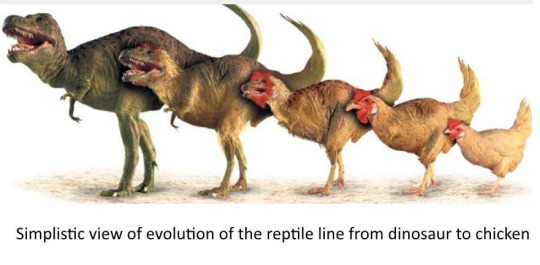
That's simply wrong. That's not how evolution works. Birds as a whole are a totally different branch of the dinosaur family from tyrannosaurs.

This is a more accurate depiction of how these two families are related. Sometime back in the Jurassic Period (we haven't found this piece, it is simply a hypothesis. Incidentally, that is another misunderstood word) the ancestor of both tyrannosaurs and aves existed. Something caused the two groups to divide. It could have been geographical separation (after all, Pangea was starting to break up).
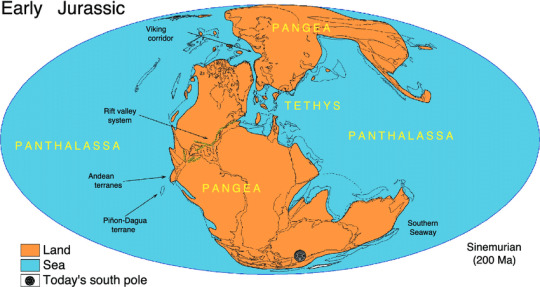
Perhaps it was something like a change in plumage or scale colors that made females choose one or the other type pf males leading to a split. Kind of like the Side-blotched Lizard. They haven't totally split but certain belly colors are preferred over others.
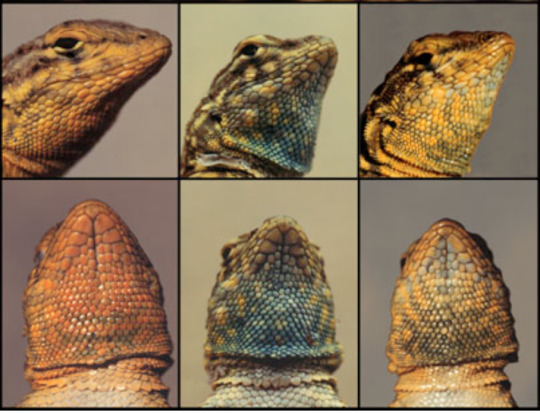
Whatever the reason, they did split and created two very different groups. One got bigger and bigger until they were some of the largest land carnivores to exist while the other got smaller and learned to fly.
Tune in tomorrow for some more tyrannosaur trivia! Fossilize you later!
#paleontology#fossils#fun facts#dinosaur#science#science education#tyrannosauridae#chicken#evolution#science side of tumblr
66 notes
·
View notes